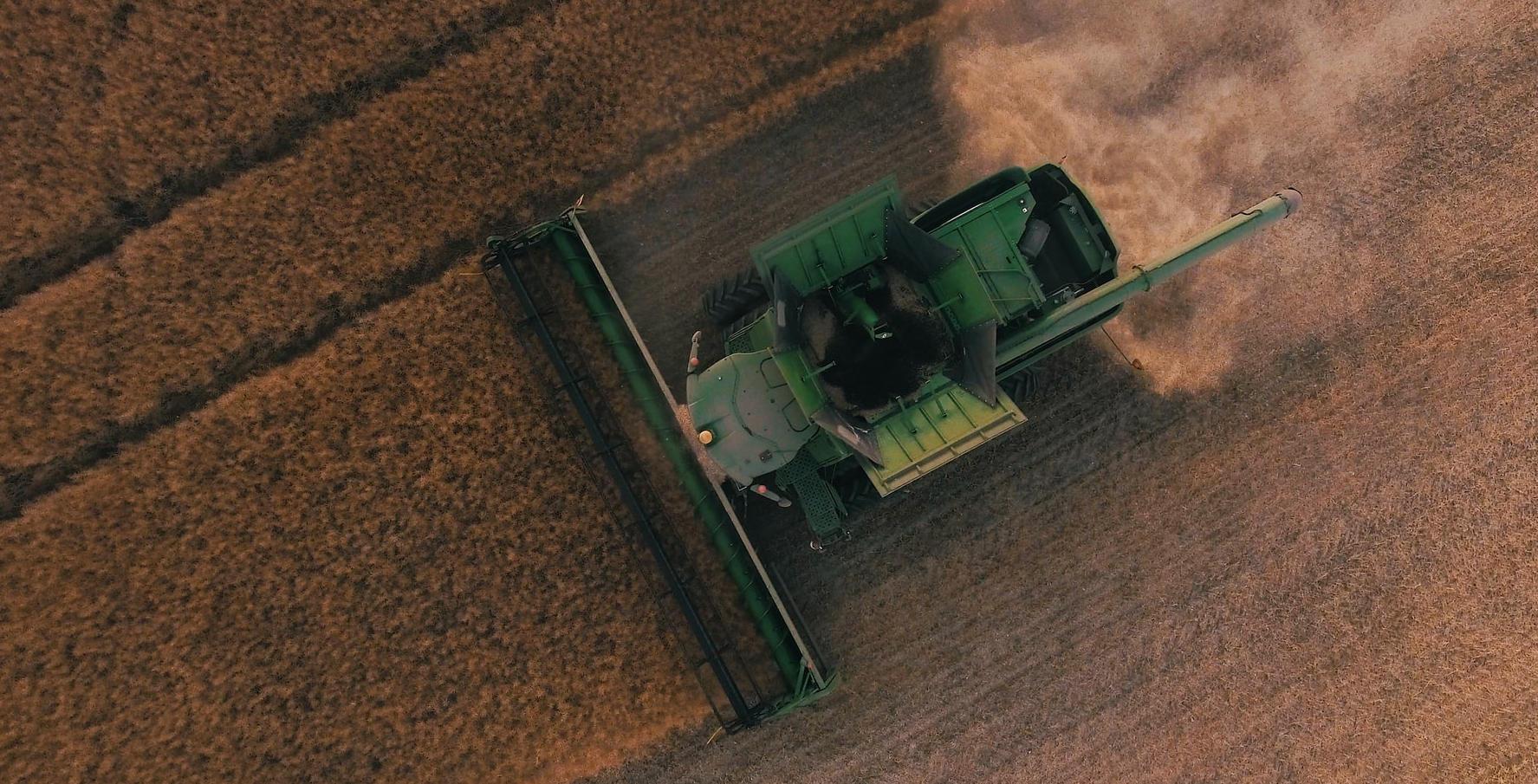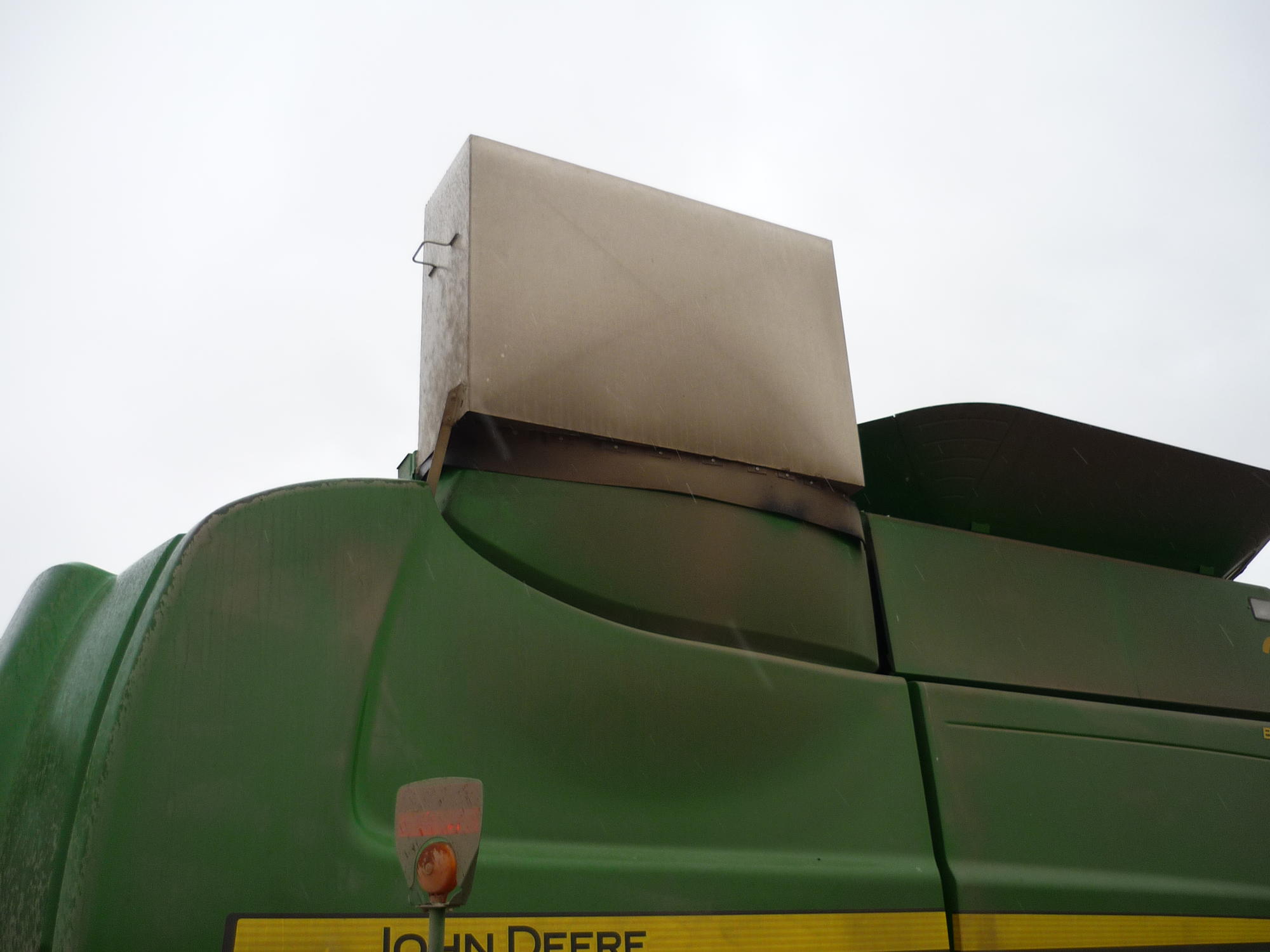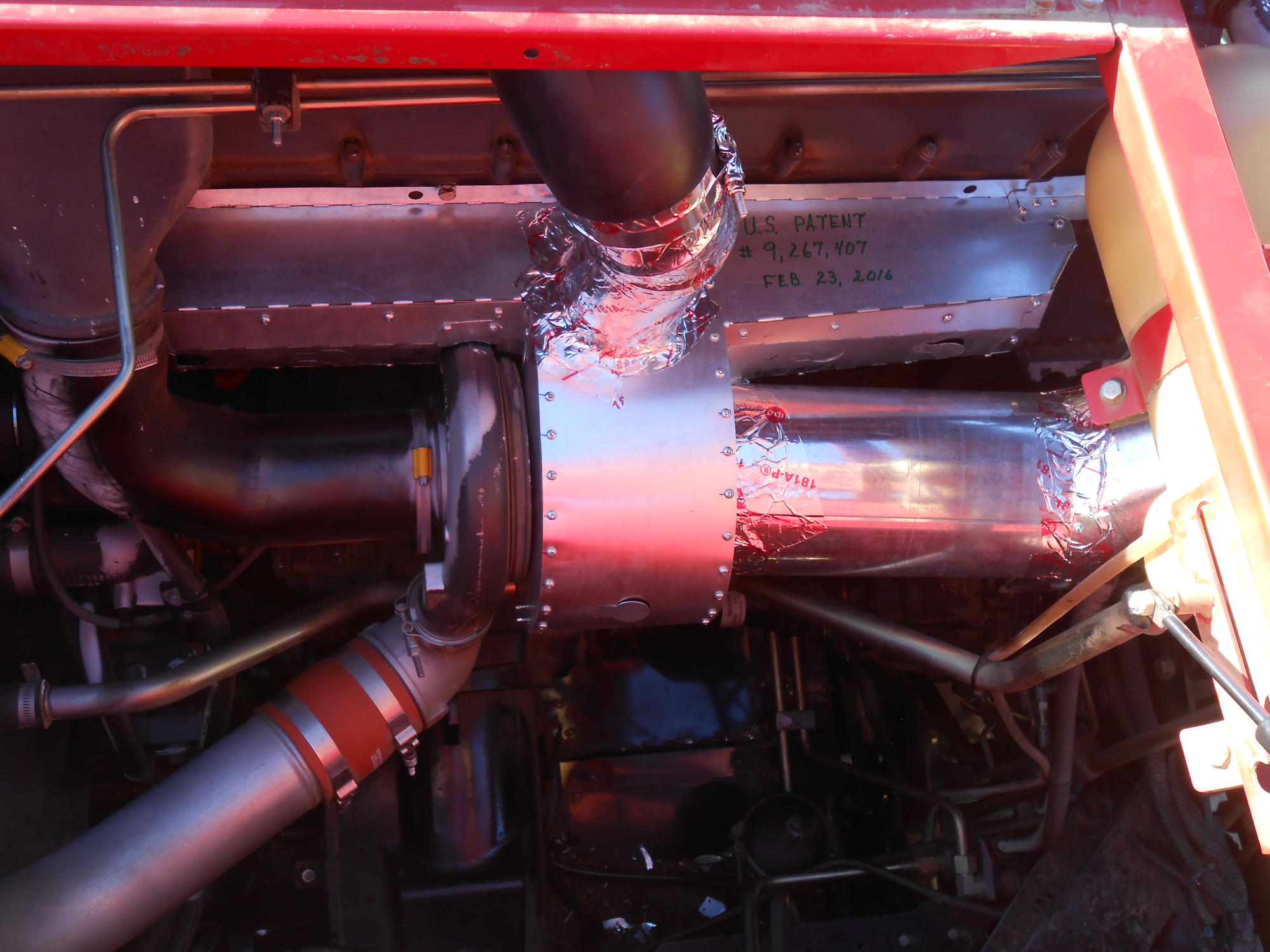Across the United States, combine fires happen every year during grain harvest. The combines farmers drive have changed dramatically in their construction over the last couple decades. Shields, panels and fuel tanks that used to be made of metal are now mostly synthetic, which can easily catch fire. When smoldering crop residue comes into contact with a hydraulic leak or fuel, it can quickly start a fire that spreads throughout the combine.
Newer equipment features improvements to reduce fires. For example, John Deere moved the air intake of the radiator on its 70 series combine to the top in 2007. This was an improvement over the 60 series, where the air intake was lower down on the side, allowing flammable crop residue to more easily enter. In addition, radiator fans have increased in power over the years, with many spinning over 60 mph to keep debris off hot engine components.
Even with these improvements, combine fires have the potential to occur. A study of 9,000 combine fires over 15 years found that 77% of combine fires start in the engine and engine bay compartment. Fires often start when crop residue comes in contact with a hot manifold, exhaust or turbocharger. New engine emission standards also cause engines to run hotter and with increased exhaust temperature. Failed bearings or electrical systems can also cause combine fires.
You can take several preventive measures before and during harvest to reduce the risk of fire.
Preventing combine fires
Don't park equipment near flashy fuels
Sometimes prevention is as simple as where you park equipment at the end of the day. Let combines cool down before parking them inside a machine shed after harvesting all day. In addition, park equipment on fire-resistant surfaces rather than in the middle of a harvested field. Sometimes equipment can malfunction while parked and potentially ignite. This is especially true for newer equipment with sophisticated electrical systems. It may be worth parking combines in a recently disked part of the field away from standing stubble and unharvested crop. Or consider disking a fire break around parked equipment if parking in areas with heavy or flashy fuels.
Avoid electrical shorts and static
Blowing several fuses might be a sign of an electrical short that is waiting to spark at the worst moment. It is worth checking hard-to-reach areas for stray or loose wires. Static electricity can also build on combines and create a small spark when discharged. Some earlier studies suggested that static electricity can start combine fires, and drag chains or other devices should be used. However, recent research shows that static electricity likely does not start fires, but is rather listed as a potential cause when poor combine sanitation is also a factor. A single spark is typically not enough to start a fire in a combine, but repeated sparking at the same location can. You can use conductive brushes fitted near rotary components, such as the radiator fan, to reduce static buildup if it becomes an issue. Case-IH sells whiskers for fans on its combines that the company suggests for producers harvesting under fire-prone conditions.
Reduce combine engine load
Increasing harvesting speed and putting combine engines under too much stress can increase the chance of fire. In addition, modern combine engines are designed to meet new emission standards, resulting in higher engine temperatures than older machines. To meet emission standards, the exhaust system uses filters to trap pollutants. Once enough pollutants collect, the engine cleans the filter by burning the soot out. This results in a clean, but extremely hot exhaust. Increasing the engine load will increase the exhaust system's temperature regardless of the machine’s age or emission system. It is best not to run the engine at full capacity. Reducing ground speeds when unloading helps the engine operate at lower pressures that keep it cooler. Similarly, consider reducing rotor speeds and keeping the header high to minimize the amount of fine dust and chaff that is produced. In many cases combines can be run up to a certain engine load threshold with a low chance of fires. However, once this threshold is surpassed, the likelihood of fire increases dramatically. The exact threshold will vary with humidity, wind speeds and crop conditions. Operate combines that are new to you at lower engine loads until you get used to operating temperatures.
Keep the bearings and sickle bar cool
A study in Spain conducted during 2018 and 2019 found that 18% of combine fires occurred in the bearings and belts. Straw chopper bearings are a common source of failure, which can cause fires. One way to ensure bearings are operating efficiently and staying cool involves the use of a $50 laser temperature gun. You can easily point the laser at any bearing to take a temperature. Consider a thorough bearing check before harvest after letting the combine warm up. Also, check during harvest while waiting for the bin wagon or truck to unload. Functioning bearing temperatures are typically in the range of 125–150 °F. Temperatures over 180 °F can cause damage. If bearing temperatures are over 300 °F, shut down equipment immediately. LM35 temperature sensors have also been used and attached to bearing housings of major bearings using JBweld. The sensors are then wired to an arduino circuit board with LED lights placed inside the cab for each bearing. You can set a temperature threshold that will trigger a light. This setup costs only around $80 per machine. You can also use laser temperature guns to check temperatures on the sickle bar and other combine components. If the sickle bar is operating under friction, it can reach 800 °F within 10–15 minutes, compared to a maximum of 125 °F under normal operating conditions. Proper maintenance and lubrication are key to reducing fire risk and keeping equipment running smoothly.
Keep combines clean
Keeping your equipment clean is the best way to prevent fires — especially around the engine, turbo charger and exhaust systems. In a study of 9,000 grain combine fires in the U.S., 41% were caused by crop residue. It is easy for crop residue to accumulate on the engine, wiring harnesses, lights, and other cracks and crevices. Blow equipment with compressed air at least once a day during harvest. Also consider power washing to remove grease and oil, which can allow a small fire to spread rapidly. This improves operating efficiency and keeps equipment cool. Diesel exhaust components and turbochargers on combines can reach 1,000–1,200 °F, and surface temperatures can reach 900 °F. Most crop residue can ignite at 500 °F and above, making it easy for fires to start when residue comes into contact with combine exhaust components.
Insulate hot surfaces
The ignition temperature for wheat varies from 480 to 645 °F, depending on the size of residue. Keep surface temperatures below 480 °F to reduce the risk of starting a fire from crop residue. One solution is to use an insulating shield on the turbocharger and other exhaust components. One study found that shields placed over turbochargers were able to reduce surface temperatures from 900 °F to 482 °F. While it is possible for wheat residue to ignite at 482 °F under the right conditions, the shield dramatically reduces the risk. Solid shields may not be suitable for all turbochargers, as they can cause turbocharger bearings to overheat. Consider placing chicken wire or coarse mesh screening around the turbocharger and exhaust system to prevent large debris from contacting hot components. In addition, use an installed fan to ensure that cool air is circulating and quickly blowing fine dust and chaff out of hot areas.
Keep flammable crop dust out
When harvesting sunflowers, chickpeas or lentils, dust buildup is often bad enough that the combine may need to be blown off as often as every 30 acres. The fine dust produced during sunflower harvest contains particles from cutting the sunflower heads, along with the outer and inner parts of stalks. The white pith from inside sunflower stalks, which is particularly flammable due its large surface area, easily sticks to engine and exhaust components. Sunflower dust and tailings that get sucked into the engine through the air intake also frequently start engine fires.
Producers and engineers have designed some solutions to the problem of crop dust. Chester Schantz, a sunflower producer in North Dakota, grew tired of multiple close calls with engine fires at his farm, where he had to blow off dust several times a day. Schantz created an 8-foot-tall chimney out of 5/8-inch plywood that attaches to the combine's air intake screen. This ensures that clean air above the dust cloud is pulled into the air intake, dramatically reducing the chance of an engine fire. Schantz has not had any close calls since installing the chimney. Stelter Repair in New Leipzig, North Dakota, came up with a design similar to Schantz's. Stelter manufactures metal chimneys at a higher price tag of $1,800 to $4,800 (Figure 1).
In addition, Dan Humburg with DSH Engineering LLC in South Dakota engineered an air intake kit to keep sunflower dust from entering the engine. The kit covers hot exhaust components and then uses a pressure blower to pull air through a filter that removes sunflower dust (Figure 2). The filtered air is then blown through the enclosed exhaust system to keep it cool (Figure 3). Kits have been developed for Case IH models (8010 through 9250) and John Deere models 9650, 9760, 9670 and 9770. Kits cost around $4,000.
Avoid harvesting during extreme fire weather
Don’t be afraid to postpone harvest for a day or a few hours during hot, dry periods with strong winds. One study that looked at 9,000 combine fires in the U.S. found that 48.5% of combine fires occurred between 2 and 4 p.m., when temperatures peak and relative humidity is the lowest. Typically, harvest occurs during dry relative humidity to improve crop harvestability and storage. As a result, fire is always a risk during harvest. The risk compounds when gusty winds align with temperatures greater than 86° F. Strong east winds in Oregon create especially low relative humidity and dry out fuels. Wind speeds over 20 mph in conjunction with relative humidity below 30% and temperatures at 90° F and above will make it difficult to put out a fire.
When using an extinguisher, remember the acronym PASS. Pull the pin at the top of the extinguisher. Aim at the base of the fire. Squeeze the lever. Sweep from side to side. Ensure that your harvest crew knows how to use fire extinguishers and where they are located. Make sure that fire extinguishers are maintained and checked at the required interval that is listed on them.
Suppressing a combine fire
Make sure to have either cell reception or radio contact with someone in the event of fire in your field. If a combine fire does start, immediately pull the machine into adjacent areas that have already been harvested. This will minimize damage to your crop and decrease flame lengths. Shut off the machine; the fan and air intake systems will continue to provide more oxygen to the flames while the machine is running. Inform the rest of the harvest crew of the fire and have someone contact emergency responders if you need additional help. Neighboring producers may be able to assist faster than the local fire district in rural areas.
Be careful opening doors or hatches to gain access to the fire. This will supply the fire with a sudden increase in oxygen, causing the fire to dramatically flare up and potentially harm you or increase damage. In addition, fire behavior will increase dramatically once heat ruptures hydraulic and fuel lines. Use fire extinguishers, pointing them at the base of the flames. Once the tires catch fire, it is unlikely that the combine can be saved. If the combine fire is beyond control, focus on keeping it from spreading to the surrounding vegetation by putting a disc line around it, or at least wet down surrounding areas. Avoid getting too close to the toxic fumes that an equipment fire can produce. The size of the containment needed will depend upon weather conditions — especially wind — and crop condition. If the fire is in a harvested part of a wheat field, expect flame lengths 6 to 7.5 feet long. In unharvested areas, flames can reach 11.5 to 16 feet, depending on how tall the crop is. Fallow areas with heavy crop residue (3 tons for a 60-bushel wheat crop) can generate heat of 1,200 BTUs (British thermal units) per square foot and 11-foot flames even at slow rates of spread (0.5 mph). If the fire gets into cheatgrass, flame lengths can easily reach 8 feet and travel at speeds of 4.5 mph. In the wind, flame lengths will increase. In addition, topography can play an important role in fire spread. Fires spread faster moving upslope and up drainages where fuels are preheated above the fire. A 20%–40% slope will cause flame lengths to double, and a 60%–80% slope will triple flame lengths.
Regardless of harvest condition, increased flame lengths and heat will require the use of equipment for direct fire suppression. Flame lengths over 4 feet will make fire suppression with hand tools dangerous and ineffective at the head of the fire. Use tractor-pulled disks to put in firebreaks at least 20 feet or wider in unharvested wheat and at least 10 feet in harvested areas. Remember that a wider fire break will be needed upslope of a fire, as flame lengths and fire behavior increase when fire moves uphill. For example, a fire break above a 30% slope would need to be wide enough (about 40 feet) to stop flames that could be 23–32 feet long if the fire is in unharvested wheat. Design firebreaks assuming that flame lengths are capable of lying flat across them in the wind. Firebreaks should be wider next to dryland crops that produce greater heat and flame lengths than surrounding fuels due to fuel density and arrangement. Also beware of rolling debris engulfed in flame traveling downhill and across containment lines. Unharvested wheat can easily start spot fires under windy conditions. Burning grain kernels can detach from the stalk and spread.
The combine operator and harvest crew may need to escape to a safety zone if the entire field is on fire and beyond control. Often, the best safety zone is inside the black, where fuels have been completely consumed. You can create a safety zone using a disk, or make use of existing rocky areas that are devoid of fuels. It is good practice to create a safety zone or identify a natural one for each field before a fire occurs, especially in fields that are surrounded by flashy annual grasses. Safety zones for most crop fires should be one-tenth of an acre for one farm truck and at least 40 feet from flames. More people and more equipment will require a larger safety zone. You will also need a larger zone if the area is upslope and downwind of the fire. (The safety area should be at least doubled if on a 20%–40% slope or under heavy winds.) Maintain two escape routes to the safety zone during harvesting operations.
Summary
With proper sanitation, maintenance, preparedness and attentiveness, the risk of a combine fire can be reduced. But there is always a chance of fire, given the nature of harvesting dryland crops. If small fires are a frequent occurrence, consider harvesting the crop at night or in the early morning when relative humidity is the highest. Other key points to remember:
- Use compressed air to remove crop residue at least once a day.
- Avoid running a combine at full capacity to reduce operating temperatures.
- Run the combine cab fan on a medium to high setting to more easily detect smoke.
- Ensure others can communicate with the combine operator via phone or radio.
- Park equipment in areas devoid of potential fuels when possible.
- Monitor the combine temperature, taking frequent readings of the bearings and other moving parts.
- Prevent crop residue and dust from coming into contact with hot engine and exhaust components.
- Remember that no piece of equipment is worth risking a life.
References
Cruz, M., R. Hurley, R. Bessell and A. Sullivan. 2020. Fire behavior in wheat crops — effect of fuel structure on rate of fire spread. International Journal of Wildland Fire, 29:10.
Davison, J. and E. Smith. 2006. A Homeowner’s Guide to Cheatgrass. EC 2364, University of Nevada, Reno, Extension.
Humburg, D. 2019. Preventing Soybean Combine Fires. iGrow Soybeans: Best Management Practices. 39:325-330. South Dakota State University Extension.
Polin, J. P., Z. Gu, D.S. Humburg and K.J. Dalsted. 2014. Source of airborne sunflower dust generated during combine harvester operation. Biosystems Engineering, 126(605):23–29.
Quick, G. 2010. An investigation into combine harvester fires. Grains Research and Development Corporation, Australian government.
Val, J., M. Videgain, P. Martin-Ramos, M. Cortés, A. Boné-Garasa, and F. Ramos. 2019. Fire Risks Associated with Combine Harvesters: Analysis of Machinery Critical Points. Agronomy, 9(12):877.
Venem, M.T., W. Gilbert, and J. Shutske. 2002. Combine Fire Prevention Summit. American Society of Agricultural and Biological Engineers, Paper No. 028017.
Windmann, Jo. 2015. Avoid sparking combine fires: Staying diligent means staying safe —and protecting your hard work from fire. Farm Journal, 139(9):57.




